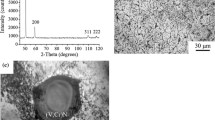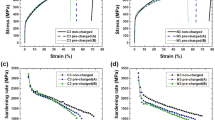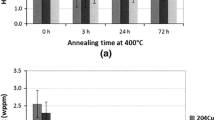Abstract
The effect of the density of grain boundaries (austenite/austenite) and phase boundaries (austenite/particle) on hydrogen embrittlement was studied in high nitrogen austenitic steel Fe-19Cr-21Mn-1.3V-0.2С-0.8N (mass %). Experiments revealed that the microscopic structural parameters such as lattice distortions, phase and grain boundaries affect the macromechanical behavior of the hydrogen-charged steel. With increasing density of grain and phase boundaries and decreasing lattice distortion of the austenitic phase, hydrogen atoms absorbed during electrolytic hydrogen charging are redistributed from interstitial positions in austenitic grains to the boundaries. This leads to a decrease in hydrogen-assisted solid solution strengthening of austenite, reduces the hydrogen-induced increase in the steel yield stress, and suppresses transgranular but promotes intergranular fracture of the hydrogen-affected layer in the tensile specimens. It was experimentally shown that an increase in the grain boundary density only, with other structural parameters unchanged, slightly improves the resistance of steel to the negative effects of hydrogen, while an increase in the total density of grain and phase boundaries has the opposite effect.






Similar content being viewed by others
REFERENCES
Johnson, W.H., On Some Remarkable Changes Produced in Iron and Steel by the Action of Hydrogen and Acids, Proc. R. Soc. Lond., 1874, vol. 23, pp. 168–179. https://doi.org/10.1098/rspl.1874.0024
Lynch, S., Hydrogen Embrittlement Phenomena and Mechanisms, Corrosion Rev., 2003, vol. 30, pp. 105–123. https://doi.org/10.1515/corrrev-2012-0502
Barrera, O., BomHNAS, D., Chen, Y., Daff, T.D., Galindo-Nava, E., Gong, P., Haley, D., Horton, R., Katzarov, I., Kermode, J.R., Liverani, C., Stopher, M., and Sweeney, F., Understanding and Mitigating Hydrogen Embrittlement of Steels: A Review of Experimental, Modelling and Design Progress from Atomistic to Continuum, J. Mater. Sci., 2018, vol. 53, pp. 6251–6290. https://doi.org/10.1007/s10853-017-1978-5
Rozenak, P. and Bergman, R., X-Ray Phase Analysis of Martensitic Transformations in Austenitic Stainless Steels Electrochemically Charged with Hydrogen, Mater. Sci. Eng. A, 2006, vol. 437, pp. 366–378. https://doi.org/10.1016/j.msea.2006.07.140
Koyama, M., Akiyama, E., Sawaguchi, T., Ogawa, K., Kireeva, I.V., Chumlyakov, Y.I., and Tsuzaki, K., Hydrogen-Assisted Quasi-Cleavage Fracture in a Single Crystalline Type 316 Austenitic Stainless Steel, Corrosion Sci., 2013, vol. 75, pp. 345–353. https://doi.org/10.1016/j.corsci.2013.06.018
Han, G., He, J., Fukuyama, S., and Yokogawa, K., Effect of Strain-Induced Martensite on Hydrogen Environment Embrittlement of Sensitized Austenitic Stainless Steels at Low Temperatures, Acta Mater., 1998, vol. 46, no. 13, pp. 4559–4570. https://doi.org/10.1016/S1359-6454(98)00136-0
Eliezer, D., Chakrapani, D.G., Altstetter, C.J., and Pugh, E.N., The Influence of Austenite Stability on the Hydrogen Embrittlement and Stress-Corrosion Cracking of Stainless Steel, Metall. Trans. A, 1979, vol. 10, pp. 935–941. https://doi.org/10.1007/BF02658313
Lo, K.H., Shek, C.H., and Lai, J.K.L., Recent Developments in Stainless Steels, Mater. Sci. Eng. R, 2009, vol. 65, no. 4–6, pp. 39–104. https://doi.org/10.1016/j.mser.2009.03.001
Bhadeshia, H.K.D.H., Prevention of Hydrogen Embrittlement in Steels, ISIJ Int., 2016, vol. 56, no. 1, pp. 24–36. https://doi.org/10.2355/isijinternational.ISIJINT-2015-430
Nagumo, M., Fundamentals of Hydrogen Embrittlement, Singapore: Springer Science + Business Media, 2016. https://doi.org/10.1007/978-981-10-0161-1
Astafurova, E.G., Melnikov, E.V., Astafurov, S.V., Ratochka, I.V., Mishin, I.P., Maier, G.G., Moskvina, V.A., Zakharov, G.N., Smirnov, A.I., and Bataev, V.A., Hydrogen Embrittlement Effects on Austenitic Stainless Steels with Ultrafine-Grained Structure of Different Morphology, Phys. Mesomech., 2019, vol. 22, no. 4, pp. 313–326. https://doi.org/10.1134/S1029959919040076
Zan, N., Ding, H., Guo, X., Tang, Z., and Bleck, W., Effects of Grain Size on Hydrogen Embrittlement in a Fe-22Mn-0.6C TWIP Steel, Int. J. Hydrogen Energy, 2015, vol. 40, pp. 10687–10696. https://doi.org/10.1016/j.ijhydene.2015.06.112
Bai, Y., Momotani, Y., Chen, M.C., Shibata, A., and Tsuji, N., Effect of Grain Refinement on Hydrogen Embrittlement Behaviors of High-Mn TWIP Steel, Mater. Sci. Eng. A, 2016, vol. 65, pp. 935–944. https://doi.org/10.1557/jmr.2017.351
Macadre, A., Tsuchiyama, T., and Takaki, S., Control of Hydrogen-Induced Failure in Metastable Austenite by Grain Size Refinement, Materialia, 2019, vol. 8, p. 100514. https://doi.org/10.1016/j.mtla.2019.100514
Panchenko, M.Yu., Melnikov, E.V., Mikhno, A.S., Maier, G.G., Astafurov, S.V., Moskvina, V.A., Reunova, K.A., Galchenko, N.K., and Astafurova, E.G., The Influence of Intergranular and Interphase Boundaries and δ-Ferrite Volume Fraction on Hydrogen Embrittlement of High-Nitrogen Steel, Int. J. Hydrogen Energy, 2021, vol. 46, no. 59, pp. 30510–30522. https://doi.org/10.1016/j.ijhydene.2021.06.183
Ovejero-Garcia, J., Hydrogen Microprint Technique in the Study of Hydrogen in Steels, J. Mater. Sci. P, 1985, vol. 20, pp. 2623–2629. https://doi.org/10.1007/BF00556094
Mohtadi-Bonab, M.A., Szpunar, J.A., and Razavi-Tousi, S.S., A Comparative Study of Hydrogen Induced Cracking Behavior in API 5L X60 and X70 Pipeline Steels, Eng. Failure Analysis, 2013, vol. 33, pp. 163–174. https://doi.org/10.1016/j.engfailanal.2013.04.028
Pu, S.D. and Ooi, S.W., Hydrogen Transport by Dislocation Movement in Austenitic Steel, Mater. Sci. Eng. A, 2019, vol. 761, p. 138059. https://doi.org/10.6052/1000-0879-22-136
Pu, S.D., Turk, A., Lenka, S., and Ooi, S.W., Study of Hydrogen Release Resulting from the Transformation of Austenite into Martensite, Mater. Sci. Eng. A, 2019, vol. 754, pp. 628–635. https://doi.org/10.1016/j.msea.2019.03.098
Ma, Z., Xiong, X., and Su, Y., Study on Hydrogen Segregation at Individual Grain Boundaries in Pure Nickel by Scanning Kelvin Probe Force Microscopy, Mater. Lett., 2021, vol. 303, p. 130528. https://doi.org/10.1016/j.matlet.2021.130528
Mai, H.L., Cui, X.Y., Scheiber, D., Romaner, L., and Ringer, S.P., An Understanding of Hydrogen Embrittlement in Nickel Grain Boundaries from First Principles, Mater. Design, 2021, vol. 212, p. 110283. https://doi.org/10.1016/j.matdes.2021.110283
Novik, F.S., Mathematical Methods for Designing Metallurgical Experiments, Part 2, Moscow: MISIS, 1979.
Naidu, S.V.N. and Singh, T., X-Ray Characterisation of Eroded 316 Stainless Steel, Wear, 1993, vol. 166, pp. 141–145. https://doi.org/10.1016/0043-1648(93)90255-K
Saltykov, S.A., Stereometric Metallography, Arlington, Va.: Armed Services Technical Information Agency, 1972.
Uggowitzer, P.J. and Harzenmoser, M., Strengthening of Austenite Stainless Steels by Nitrogen, in Proc. HNS 88, London: Institute of Metals, 1989, pp. 174–179. https://doi.org/10.1007/BF03220991
Panchenko, M.Y., Maier, G.G., Tumbusova, I.A., Astafurov, S.V., Melnikov, E.V., Moskvina, V.A., Burlachenko, A.G., Mirovoy, Y.A., Mironov, Y.P., Galchenko, N.K., and Astafurova, E.G., The Effect of Age-Hardening Mechanism on Hydrogen Embrittlement in High-Nitrogen Steels, Int. J. Hydrogen Energy, 2019, vol. 44, no. 36, pp. 20529–20544. https://doi.org/10.1016/j.ijhydene.2019.05.240
Astafurov, S.V., Maier, G.G., Tumbusova, I.A., Melnikov, E.V., Moskvina, V.A., Panchenko, M.Yu., Smirnov, A.I., Galchenko, N.K., and Astafurova, E.G., The Effect of Solid-Solution Temperature on Phase Composition, Tensile Characteristics and Fracture Mechanism of V-Ccontaining CrMn-Steels with High Interstitial Content C + N > 1 mass %, Mater. Sci. Eng. A, 2020, vol. 770, p. 138534. https://doi.org/10.1016/j.msea.2019.138534
Bannych, O.A., Blinov, V.M., Poimenov, I.L., and Kunavin, S.A., Effect of Vanadium on the Structure and Mechanical Properties of Nonmagnetic High-Nitrogen Steels, Met. Sci. Heat Treat., 1982, vol. 24, no. 5, pp. 335–337. https://doi.org/10.1007/BF00782806
Ashby, M.F., Work Hardening of Dispersion-Hardened Crystals, Philos. Mag., 1966, vol. 14, no. 132, pp. 1157–1178. https://doi.org/10.1080/14786436608224282
Gladman, T., Precipitation Hardening in Metals, Mater. Sci. Technol., 1999, vol. 15, no. 1, pp. 30–36. https://doi.org/10.1179/026708399773002782
Petch, N.J., The Cleavage Strength of Polycrystals, J. Iron. Steel. Inst., 1953, vol. 174, pp. 25–28. https://doi.org/10.1016/0013-7944(87)90050-6
Hall, E.O., The Deformation and Ageing of Mild Steel: III Discussion of Results, Proc. Phys. Soc. B, 1951, vol. 64, pp. 747–753. https://doi.org/10.1088/0370-1301/64/9/303
Ulmer, D.G. and Altstetter, C.J., Phase Relations in the Hydrogen-Austenite System, Acta Metall. Mater., 1993, vol. 41, pp. 2235–2241. https://doi.org/10.1016/0956-7151(93)90393-7
Brass, M. and Chêne, J., Hydrogen Uptake in 316L Stainless Steel: Consequences on the Tensile Properties, Corrosion Sci., 2006, vol. 48, no. 10, pp. 3222–3242. https://doi.org/10.1016/j.corsci.2005.11.004
Macadre, A., Nakada, N., Tsuchiyama, T., and Takaki, S., Critical Grain Size to Limit the Hydrogen-Induced Ductility Drop in a Metastable Austenitic Steel, Int. J. Hydrogen Energy, 2015, vol. 40, no. 33, pp. 10697–10703. https://doi.org/10.1016/j.ijhydene.2015.06.111
Robertson, I.M., Birnbaum, H.K., and Sofronis, P., Hydrogen Effects on Plasticity: Chapter 91, in Dislocations in Solids, Amsterdam: Elsevier, 2008, vol. 15, pp. 249–293. https://doi.org/10.1016/S1572-4859(09)01504-6
Birnbaum, H.K., Hydrogen Effects on Deformation Relation between Dislocation Behavior and the Macroscopic Stress–Strain Behavior, Scripta Metall. Mater., 1994, vol. 31, pp. 149–153. https://doi.org/10.1016/0956-716X(94)90166-X
Oriani, R.A., Hirth, J.P., and Smialowski, M., Hydrogen Degradation of Ferrous Alloys, Park Ridge, USA: Noyes Publications, 1985. https://doi.org/10.1557/S0883769400069670
Oudriss, A., Creus, J., Bouhattate, J., Conforto, E., Berziou, C., Savall, C., and Feaugas, X., Grain Size and Grain-Boundary Effects on Diffusion and Trapping of Hydrogen in Pure Nickel, Acta Mater., 2012, vol. 60, pp. 6814–6828. https://doi.org/10.1016/j.actamat.2012.09.004
ACKNOWLEDGMENTS
The authors are grateful to Cand. Phys.-Math. Sci. N.K. Galchenko, E.V. Melnikov, Cand. Phys.-Math. Sci. S.V. Astafurov, K.A. Reunova, and V.A. Moskvina for help in preparing materials and conducting experimental studies.
Funding
The study was funded by the Russian Foundation for Basic Research, project number 20-38-90129, and was performed according to the government statement of work for ISPMS SB RAS, research line FWRW-2022-0005.
Author information
Authors and Affiliations
Corresponding author
Additional information
Translated from Fizicheskaya Mezomekhanika, 2022, Vol. 25, No. 3, pp. 84–97.
Rights and permissions
About this article
Cite this article
Panchenko, M.Y., Nifontov, A.S. & Astafurova, E.G. Microstructural Effect on Hydrogen Embrittlement of High Nitrogen Chromium-Manganese Steel. Phys Mesomech 25, 453–465 (2022). https://doi.org/10.1134/S1029959922050083
Received:
Revised:
Accepted:
Published:
Issue Date:
DOI: https://doi.org/10.1134/S1029959922050083




